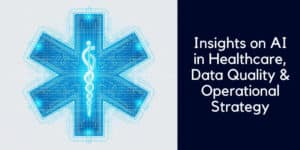What’s inside:
AI technology is making its mark in healthcare, and you have two choices – to embrace innovation or risk stagnation.
New supply chain automation tools continue to add precision and automation to healthcare management, so standing still is just not an option.
The health-tech landscape is transforming how healthcare providers operate, and those that are slow to adopt new healthcare technology may struggle to compete.
AI, machine learning, image recognition, RFID and digital scale technology are just some of the technologies replacing all those slow, inefficient, manual workflows which once typified healthcare supply chain management.
In this blog, we’ll explore the dangers of sticking with the status quo, and highlight the importance of embracing innovation.
Revolutionizing Supply Chain Management
As manual processes are replaced by digital supply chain solutions, human involvement in healthcare materials management is gradually being minimized.
Supply chain automation reaps many rewards for both clinical staff, managers and leadership. It:
- Reduces manual tasks – freeing up staff for other duties.
- Achieves better, more accurate results in less time.
- Reduces wastage.
- Boosts cost-savings
- Streamlines workflows.
- Enables data-driven healthcare supply chain decisions.
Automation helps healthcare organizations to achieve more with less. As we continue to struggle with nurse staffing shortages, that’s got to be a good thing!
However, while many providers recognize the benefits of embracing new supply chain technology, others are more reticent to change the way they work.
Why is this?
Beyond the comfort zone: The dangers of sticking with the status quo in healthcare
There’s comfort and security in sticking with what you know. Change is for the brave, or better-funded, right?
When you’re so busy, and your budgets are tight, investing in technology can seem like one disruption too many.
It takes time, planning, and multiple staff.
It requires new equipment, systems and training.
It’s easier to put it off for tomorrow, rather than take action today.
But take a moment and consider this.
Could sticking with the status quo actually impede your growth?
Could it allow your competitors to gain strength, as your organization stagnates?
Instigating change is hard, but with the right partner and supply chain technology, disruption is minimized.
And what’s more. you can rest assured that on your watch, you took the necessary steps to future-proof your organization.
This is a pivotal moment.
As technology transforms organizations, sharpening their competitive edge, you can stand still, or you can take a leap into the future.
It doesn’t need to be a massive investment, you can ease yourself in gently and plan a phased approach.
But the important thing?
Just start.
Do not stand still.
It really isn’t an option anymore.

Trends in Healthcare IT technologies
A recent article on AI in Healthcare looked at the spending priorities of more than 200 high level clinical and clinical IT staff at large and medium-size healthcare provider institutions – the consensus was to prioritize the emerging technologies that are reshaping US healthcare.
The survey had some interesting outcomes:
- Digital transformation was a higher priority (53%) than cost reduction (35%) and improving care quality (31%).
- 88% expect to increase their investment in third-party technologies, not including EHR.
- 85% expect increased organization-wide investment and 28% feel that AI for clinical applications will be in the top three.
The article gives three pieces of advice to healthcare providers:
- Trust the third-party technologies: Invest in reliable, cost-effective technologies where and partner with vendors who can demonstrate expertise, ease of deployment and deliver data reliability.
- Act on the rise of automation: Technology is the key to optimizing clinical operations and improving patient satisfaction.
- Embrace emerging technology: Staying ahead, explore the application of 5G, AI, and machine learning to gain a competitive edge in an ever-more competitive healthcare sector.

Why failing to invest in technology impedes organizational efficiency
So, what’s the cost of doing nothing? How does sticking with the current way of working affect the management of the hospital supply chain?
Well let’s just compare a few supply chain tasks undertaken by nursing staff – the reality of pre-automation when compared to post-automation.
| Task | Before Automation | After Automation |
| Finding the items needed for surgery | These are all common occurrences:
| The best smart cabinet automation ensures inventory is available on demand.
|
| Using a smart cabinet slashes the time it takes nurses to pull together all the hospital inventory needed for surgery. It literally saves hours of nursing time per day. | ||
| Managing medical supplies in the department | Manual Kanban or PAR bins involve nurses and logistics staff monitoring the supplies and requesting restocks. Nurses routinely hoard items due to ‘stock insecurity’. This practice obscures true stock levels. | Advanced, automated Kanban & PAR automation technology can significantly reduce, or eliminate, nurse involvement in supply chain activity. Adding automation to stock monitoring and using automated restocks when the order point is reached, prevent stock outs. |
| An automated Kanban and PAR system ensures nurses always have the items they need at hand and minimizes the amount of time they spend on supply chain activities. See a customer case study on the impact of adding automated Kanban and PAR technology to one hospital department. | ||
| Documenting product usage in surgery | Many providers have a barcode scanning system in place to capture the reportable items used in surgery. Barcode systems frustrate nurses who are dealing with multiple barcodes, scanning issues and system issues. In particular items not preloaded into the Item Master, such as bill-only items, are longwinded to handle. Many items require additional data entry straight onto the hospital system. It all takes time away from direct patient care. | New advances, such as image-recognition and AI technology are completely changing surgical documentation. New computer vision technology at the point of care ensures that item capture is now quick and simple. Item identification is automated and doesn’t rely upon an up-to-date hospital Item Master. Item documentation into the EHR, ERP and MMIS is automated. Nurses no longer need to suffer with time consuming supply chain admin. Simplified surgical documentation enables nurses to focus on supporting the clinical team and direct patient care. Full item and charge capture is achieved with minimal effort. |
| Replacing old, inadequate surgical documentation technology ensures healthcare providers have data integrity at the point of care. This vital data feeds into hospital systems, ensuring efficient hospital administration, accurate procurement and optimized OR revenue. See a case study on the impact of adding smart cabinets and computer vision technology at the point of care in a medical center. | ||
Without automation:
- Staff capacity is reduced, and nurses are bogged down by time-heavy supply chain activity.
- Surpluses and stock outs are common as procurement is ‘best-guess’ not data-driven.
- Patient safety is undermined by an inaccurate or incomplete patient file.
- Medical Device recall management and regulatory compliance is compromised by failure to digitally track the full details of every item.
- Vital supply chain data fails to make it onto the hospital system and into administrative and operational workflows.
The Path Forward
Many healthcare providers are embracing new technology.
In a recent survey from Statista 51 percent of US healthcare organizations surveyed in 2022 reported they were currently considering AI/machine learning tech to automate manual processes and reduce costs.
If you want your hospital or surgery center to move from surviving to thriving, then a proven and transformative route is to embrace technology.
Standing still is the risky option – leveraging technology is the safer bet.
If you want advice, support or ideas on how to introduce supply chain automation into your healthcare organization, contact us.

Let’s tackle a few common fears about adopting new technology:
Fear 1: We have a complex range of IT systems, and I don’t want to add anything new into the mix.
Worry not! All our solutions offer easy integration with all common hospital systems, such as Cerner. We’re just an add-on that enhances, and doesn’t replace, what you already have.
Fear 2: We’re not sure where to start. There are so many options.
You don’t need to figure it all out yourself. Treat us as your development partners. Our starting point is your current system, set-up, workflows, staffing. We look at where you are, consider where you want to be, and build a bridge to get you there.
Fear 3: We have a limited budget and need to use it where it has most effect.
First of all, we work in partnership with you and are happy to move at your pace, and within your budget. We can advise you on how to get the biggest impact from the funds you have available.
We can provide a staged implementation plan that suggests the initial tools to implement, as well as provides ideas for the continuing automation of your supply chain activities over time.
Fear 4: We need to plan ahead and anticipate growth.
We have a single cloud management system for our different solutions. Once the platform is integrated, all future additions simply link into the same software, without any additional inconvenience.
Our managing software is built to embrace scalability.
Contact us to discuss how technology can future-proof your healthcare delivery. We want to share our knowledge, experience and ideas.
Let’s talk.






